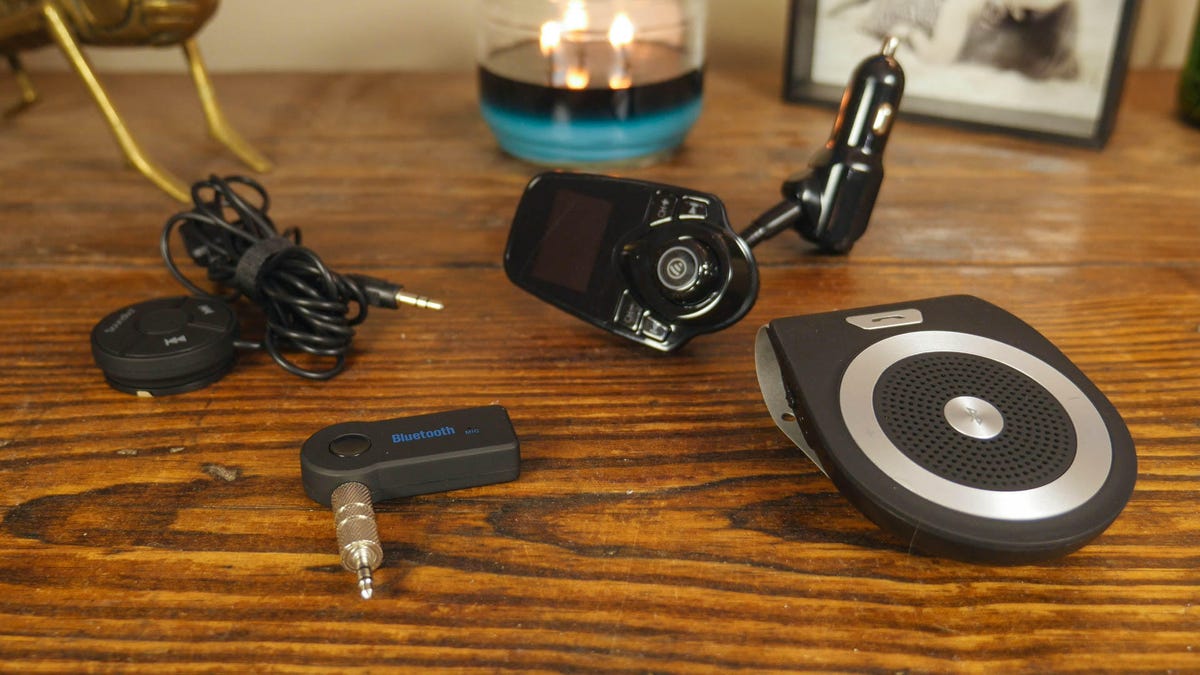 Why You Can Trust CNET
Why You Can Trust CNET How to add Bluetooth to an old car
If you want to listen to your own tunes while driving, here are four ways to add Bluetooth to any car.

Bluetooth is now a standard feature in practically every modern car. Like with Bluetooth headphones, a Bluetooth-enabled car lets you stream your own tunes or favorite podcasts on your daily commute without the hassle of CDs or the monthly cost of internet radio.
If you're driving an older car, however, you might not have the luxury of streaming over Bluetooth. The upshot is that the price of Bluetooth technology has come down and adding it to any car is affordable and painless.
Here are the most common ways to add Bluetooth to your daily driver.
Bluetooth receiver
By and large, the easiest and most common way to add Bluetooth to a vehicle's radio is by using a Bluetooth receiver. With a Bluetooth receiver, you pair your phone to the receiver and stream audio to it. The receiver then plugs into the 3.5mm input jack (auxiliary in) typically found near the center controls or inside the center console.
Because every car is different, Bluetooth receivers come in a few different configurations:
- 12V-powered
- USB-powered
- Battery-powered
In many cases, the auxiliary in jack is grouped with a USB port that should provide enough juice to power a Bluetooth receiver. In this case, or if you've got a 12V USB charger that has an extra port, it's best to go with a USB-powered receiver, such as Anker's SoundSync Drive or the SoundBot, pictured above.
The biggest problem with the above receivers is that they're made on the assumption that your 12V socket or a USB port will be located near the auxiliary in jack. That is not always the case.
If your 3.5mm input is nowhere near a USB port or 12V socket, you're better off buying a battery-operated Bluetooth receiver that can be positioned anywhere within the vehicle. Of course, it will need to be charged regularly, but you can do that by plugging it into the car charger when it's not in use or taking it with you when you arrive home and charging it there.
FM Transmitter
If your car or radio doesn't have an auxiliary input, you'll be better off with an FM transmitter. Effectively, the FM transmitter of today is a Bluetooth receiver, but instead of sending the audio to the stereo via an auxiliary cable, it broadcasts it over an open FM radio frequency. Tune your stereo's FM tuner to the correct frequency and you should hear your audio.
Previous versions of FM transmitters suffered from static, weak signal and overall poor audio quality, but reviews of more recent models are more promising.
Another boon for the FM transmitter is the lack of wires. Since the Bluetooth signal gets transmitted over FM frequencies, there is no need for wires hanging around. Instead, FM transmitters typically plug into the 12V socket and sometimes have built-in USB charging ports.
Dedicated speakerphone
If you don't mind not being able to stream your music through your car's stereo, you can opt for a dedicated Bluetooth speakerphone. In most instances, these clip to the sun visor above the driver and pair to your phone like any Bluetooth speaker . When you answer a call, both the audio and microphone input are handled by the visor-mounted speakerphone.
The downside to a Bluetooth speakerphone is that they're often the more expensive option with the least amount of features.
New head unit
Another, albeit far more expensive option, is to replace the head unit in your car altogether with one that has Bluetooth built-in. Instead of paying $15 to $30 (£10 to £20 or AU$20 to AU$40), you'll be looking at anywhere from $80 to upwards of $700 (£60 to £530 or AU$100 to AU$870).
On the bright side, what you get is more polish and fewer wires hung around your vehicle. You can also choose to upgrade your car's head unit to an Android Auto or CarPlay, and some head units come with beneficial add-ons, such as backup cameras. So while the investment might be larger, it also comes with a broader range of additions that can breathe new life into an aging car interior.
The one thing to consider, however, is that this option is not plug and play like a Bluetooth receiver or FM transmitter. If you're not familiar with working with head unit wiring hardness adapter kits, you will also need to pay to have the unit installed.
Wired alternative: 3.5mm auxiliary cable
Maybe you're not totally worried about having truly wireless audio in your car. That's definitely understandable. Sometimes, simply plugging in a cable is easier to manage.
If you fall into this category, the cheapest and most direct alternative is a 3.5mm auxiliary cable. Effectively, it's a cable with a male 3.5mm plug on both ends. One end plugs into the headphone jack on your smartphone and the other end is plugged into the auxiliary in on the car. Any audio you play from the phone will then play through the stereo.
The biggest disadvantage to this is that if you receive a call while the phone is plugged into the car stereo, the audio will play through the car's speakers, but the audio input will still be the phone's microphone. This means you must hold the phone near your mouth or remove the cable and enable speakerphone -- neither of which are totally hands-free, making it unsafe and even illegal in some states.

